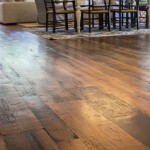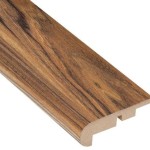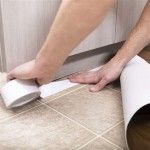Understanding Threshold Laminate Flooring Installation Instructions
Laminate flooring offers a durable and aesthetically pleasing alternative to hardwood, often at a more affordable price point. A critical component of a professionally installed laminate floor is the correct installation of thresholds. Thresholds, also known as transition strips, bridge the gaps between different flooring types or different heights of the same flooring within a building. Understanding and adhering to the manufacturer's instructions for threshold installation is paramount to achieving a seamless, safe, and long-lasting flooring system.
This article delves into the complexities of threshold laminate flooring installation instructions, focusing on key considerations and common pitfalls to avoid. It examines the types of thresholds, preparation requirements, installation techniques, and troubleshooting strategies typically outlined in manufacturer guidelines. The information presented aims to equip individuals with the knowledge necessary to interpret and execute these instructions effectively.
Types of Thresholds for Laminate Flooring
The first step in a successful threshold installation is identifying the appropriate type of threshold for the specific application. Thresholds are not a one-size-fits-all component; their design and function vary based on the adjoining flooring types and the height difference between them. Manufacturers usually specify the recommended threshold type within their installation guides.
T-Molding: This type of threshold is designed to join two floors of the same height. It creates a flush transition between two laminate floors, or between laminate and another hard surface flooring like tile or hardwood if both floors are precisely level. The T-molding typically features a T-shaped profile, with the top spanning the gap and the legs fitting into channels or grooves created in the subfloor or within the laminate locking system itself.
Reducer Strip: When laminate flooring transitions to a lower floor covering, such as vinyl or carpet, a reducer strip is employed. This threshold has a sloped profile, gently transitioning from the higher laminate floor to the lower adjacent floor. The angle of the slope is crucial for safety and aesthetics, preventing tripping hazards and providing a visually appealing transition.
End Cap: An end cap, also called a square-nose molding, is used where the laminate floor ends abruptly, such as at a doorway without a door jamb, or where it meets a vertical surface like a sliding glass door track. The end cap provides a finished edge to the laminate, concealing the cut edge and protecting it from damage. It often has a flat, slightly rounded or squared-off profile.
Overlap Reducer: This type of threshold is used to bridge the gap between laminate flooring and existing flooring such as hardwood or tile, often used when replacing flooring without removing the existing floor. The overlap design features a lip that extends over the edge of the existing floor, creating a visually appealing transition and covering any minor imperfections in the cut edge of the laminate.
Understanding the specific requirements of each threshold type is crucial for selecting the correct product and following the manufacturer's installation guidelines precisely. Using the wrong threshold can lead to an unsightly appearance, potential safety hazards, and accelerated wear and tear on the flooring.
Preparing for Threshold Installation
Proper preparation is just as critical to threshold installation as the physical act of fitting the threshold into place. Manufacturer instructions invariably emphasize the importance of meticulous preparation, as this directly impacts the final result and long-term performance of the flooring system. This preparation encompasses several key aspects:
Subfloor Inspection and Preparation: The subfloor must be clean, level, and structurally sound. Any imperfections, such as cracks, holes, or unevenness, must be addressed before installing the threshold. Use leveling compound to fill low spots and repair any structural damage. A solid, stable subfloor is essential for ensuring the threshold is securely anchored and able to withstand foot traffic.
Accurate Measurements: Taking precise measurements of the gap between the flooring surfaces is paramount. The threshold must be cut to the exact length of the opening. Manufacturer instructions often specify an allowance for expansion gaps or slight variations in the flooring surface. Failing to measure accurately can result in gaps or overhangs, compromising the appearance and functionality of the threshold.
Acclimation of Thresholds: Some manufacturers recommend acclimating the thresholds to the room's temperature and humidity for a period of time before installation. This allows the threshold material to expand or contract, minimizing the risk of warping or cracking after installation. The acclimation period is usually specified in the installation instructions.
Gathering Necessary Tools and Materials: Ensure all necessary tools and materials are readily available before commencing the installation. This typically includes a saw (miter saw or hand saw), measuring tape, pencil, drill, screws or adhesive (as specified by the manufacturer), safety glasses, and a dust mask. Having all the right tools on hand will streamline the installation process and minimize delays.
Understanding the Expansion Gap: Laminate flooring expands and contracts with changes in temperature and humidity. Threshold installation must accommodate this movement. The manufacturer's instructions will specify the required expansion gap between the laminate flooring and the threshold, as well as between the threshold and the adjoining flooring surface. Failing to provide adequate expansion gaps can lead to buckling or cracking of the flooring and/or the threshold.
By meticulously addressing these preparation steps, the likelihood of encountering problems during installation is significantly reduced, and the overall quality of the finished project is enhanced.
Installation Techniques and Troubleshooting
The actual installation of the threshold involves specific techniques that must be followed closely to ensure a secure and aesthetically pleasing result. Manufacturer instructions typically provide detailed step-by-step guidance on the installation process, often accompanied by diagrams or illustrations. Adhering to these instructions is crucial for achieving the desired outcome.
Cutting the Threshold: Use a sharp saw to cut the threshold to the correct length. A miter saw is recommended for achieving precise, angled cuts. Always wear safety glasses and a dust mask when cutting the threshold material. Manufacturer instructions may specify the type of blade to use for optimal cutting performance and to prevent splintering.
Securing the Threshold: The method for securing the threshold will vary depending on the type of threshold and the subfloor material. Some thresholds are designed to be glued down using construction adhesive, while others are secured with screws. If using screws, pre-drill pilot holes to prevent splitting the threshold material. Ensure the screws are the correct length to penetrate the subfloor securely without protruding through the flooring below.
Addressing Height Discrepancies: When transitioning between floors of different heights, shims may be required to level the threshold and ensure a smooth transition. The manufacturer's instructions may provide guidance on how to use shims effectively. Ensure the shims are securely fixed in place to prevent them from shifting over time.
Concealing Fasteners: Some thresholds feature a channel or groove that conceals the screws or adhesive. Follow the manufacturer's instructions for properly concealing these fasteners. This will enhance the aesthetic appearance of the threshold and prevent tripping hazards.
Sealing the Edges: In areas prone to moisture, such as bathrooms or kitchens, it is recommended to seal the edges of the threshold with a waterproof sealant. This will prevent water from seeping under the threshold and damaging the subfloor. The manufacturer's instructions may specify the type of sealant to use.
Troubleshooting Common Issues: Installation instructions often include a section on troubleshooting common issues. These might include problems such as gaps between the threshold and the flooring, loose or wobbly thresholds, or uneven transitions. Understanding these troubleshooting tips can help resolve problems quickly and efficiently.
By meticulously following the manufacturer's installation techniques and addressing any issues that arise promptly, a durable, aesthetically pleasing, and safe threshold installation can be achieved. Ignoring these instructions can lead to premature failure of the flooring system and potential safety hazards. Thoroughly review and understand the instructions before commencing the installation process.
Ultimately, successful threshold installation requires a blend of careful planning, precise execution, and a thorough understanding of the manufacturer's specific instructions. By taking the time to prepare properly, selecting the right materials, and following the recommended installation techniques, a seamless and long-lasting transition between flooring surfaces can be achieved.

How To Install Flooring Threshold Bars In 4 Simple Steps Esb

How To Install Vinyl Flooring Transition Strip Lvp Moulding

Installing And Cutting Mohawk S Instaform Profile Onflooring

Guide To Installing Laminate Flooring Diy Family Handyman

How To Install Flooring Threshold Bars In 4 Simple Steps Esb

Home Diy How To Install Transition Strips On New Floor Partselect Com

Bekayaa Self Adhesive Floor Transition Strip Black Laminate Threshold Elegant Wood Grain Seam Cover Door Trim 1 Pack

How To Install Laminate Flooring The Home Depot

How To Stagger Vinyl Plank Flooring Step By Guide

Your Ultimate Guide To Installing Wooden Thresholds At Home Timber2udirect
Related Posts








